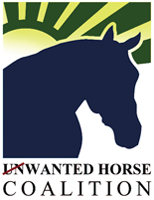|

|
 |
A Call for Help: Your Input is Needed
in a Nationwide Survey on the Problem of Unwanted Horses The problem of unwanted horses is being studied through a nationwide initiative of the Unwanted Horse Coalition (UHC) with help from equine associations, veterinarians, breeders, state and local law enforcement, horse owners, rescue/retirement facilities, and other facilities using horses. The first step is an online survey — and everyone with an interest in the welfare of horses is encouraged to respond at http://survey.ictgroup.com/uhcsurvey/. With tens of thousands of unwanted, neglected and abandoned horses in the United States, some say the problem is a fast-growing epidemic. However, much remains unknown. Currently, there are few documented facts about the accurate number of unwanted horses, their age, sex, breed, recent use, value or what happens to them in the long run. “Although there are numerous media reports and much anecdotal evidence of a growing problem with unwanted horses, there have been no studies or surveys done to attempt to document it,” said Jay Hickey, president of the American Horse Council (AHC), the national association that represents all segments of the horse industry in Washington, D.C. The UHC operates with the AHC. “The downturn in the economy, rising costs of hay, the drought that has affected many parts of the United States, the costs of euthanasia and carcass disposal, and the closing of the nation’s slaughter facilities have all made the problem worse. But no one knows its magnitude. That’s why the first step toward a solution is to gather and examine the facts. The goal of this survey is to get the input, observations, opinions and suggestions from anyone and everyone involved with horses.” The Study on Contributing Factors Surrounding the Unwanted Horse Issue will be instrumental in filling factual gaps with actual data on:
Pase I of the study is an online survey of people most affected by and involved with the issue of the unwanted horse. An independent research firm developed the questionnaire and is hosting the online survey site at http://survey.itcgroup.com/uhcsurvey/. The firm will also tabulate and analyze responses, and provide a full report. A comprehensive view of the problem depends on representation from all corners of the horse industry, according to Dr. Tom Lenz, chairman of the UHC. “To ensure the broadest possible participation, we’re working to involve a variety of individuals, associations, state and local agencies, and equine-related companies to actively encourage their constituencies to take the survey and voice their opinions.” The American Association of Equine Practitioners defines the term “unwanted horse” as, “Horses which are no longer wanted by their current owner because they are old, injured, sick, unmanageable, fail to meet their owner’s expectations, or the owner can no longer afford or is incapable of caring for them.” This definition, according to Lenz, is a starting point to discover what’s causing the problem and what can be done to correct it. “Regardless of how horses reached this state, every owner—and the equine industry at large—has a responsibility to ensure that everything possible is done to guarantee the humane care and treatment of unwanted horses,” Lenz said. “Our message now is to please go to http://survey.itcgroup.com/uhcsurvey/, and provide us with feedback. Answers will be confidential. More important, this feedback will be invaluable in developing a strategy to solve the problem.” |
| Back to News |
BENEVOLENCE | BENEFITS | GROOM ELITE | PERSONNEL | LINKS | CONTACT US
